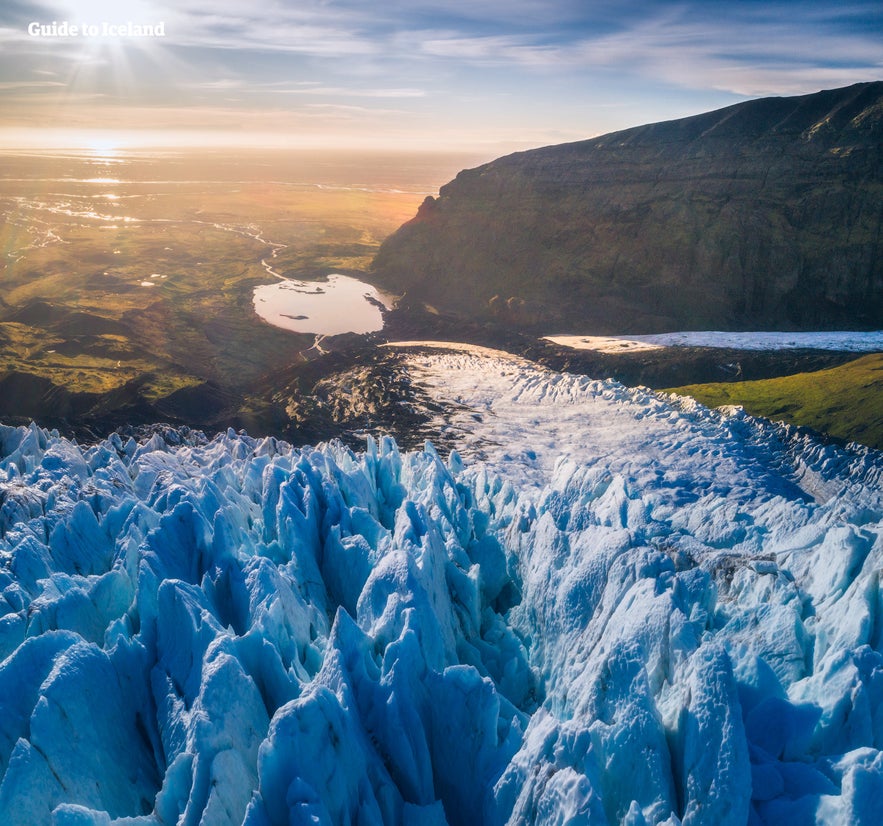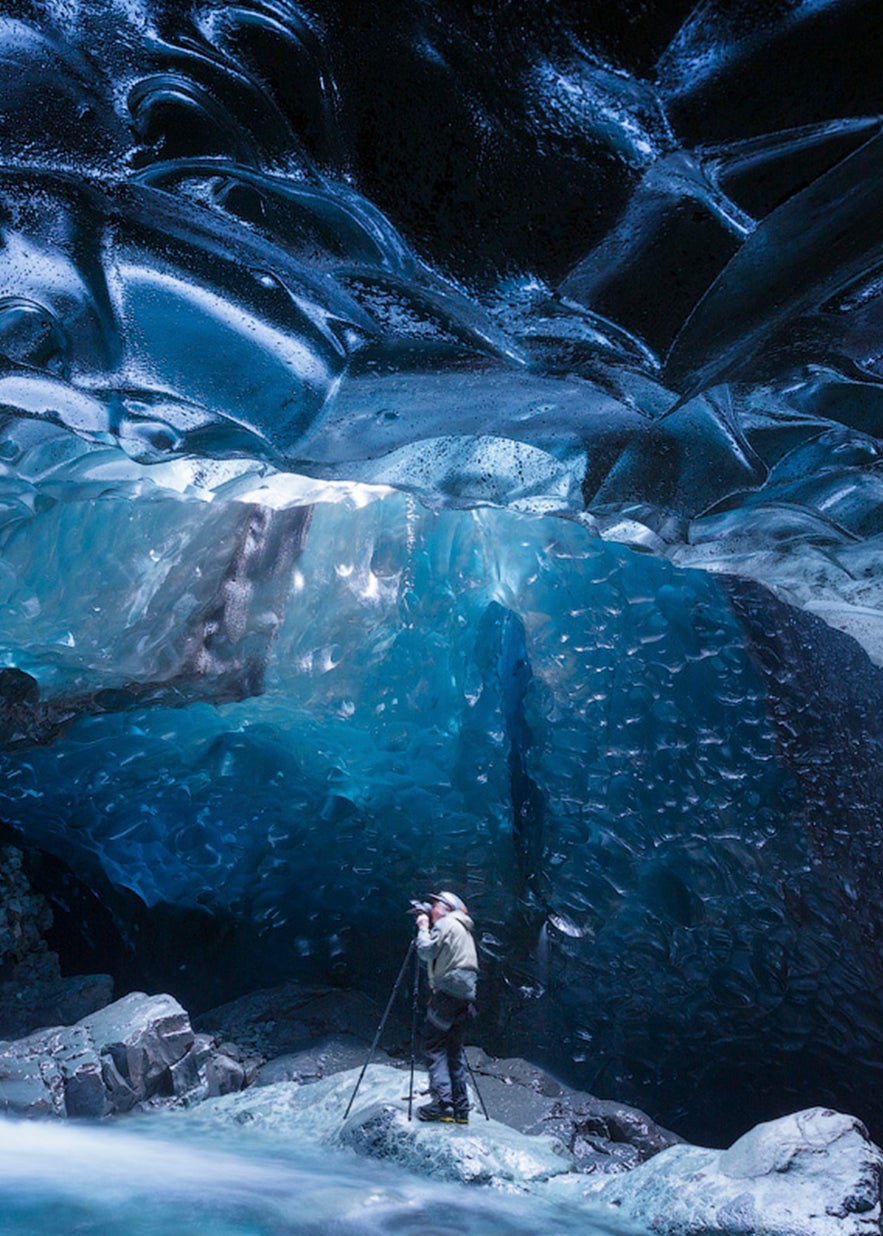Il ghiacciaio Vatnajokull (scritto Vatnajökull in islandese), è il più grande ghiacciaio d'Europa e copre l'8% della superficie del territorio dell'Islanda.
Le sue dimensioni enormi rendono possibile, in alcune sue parti, innumerevoli visite in tour autoguidati, pacchetti vacanze con guida inclusa e tour della Costa Sud. Questo tour estivo di 10 giorni con auto a noleggio e questa vacanza estiva di 6 giorni sono esempi che offrono l'opportunità di visitare molte delle sue zone. Può essere esplorato anche da chi noleggia un'auto.
Perché puoi contare sui nostri contenuti
Guide to Iceland è la piattaforma di viaggi più affidabile d’Islanda, che ogni anno aiuta milioni di viaggiatori. Tutti i nostri contenuti sono scritti e verificati da esperti locali con una conoscenza approfondita del Paese. Potete contare su di noi per consigli di viaggio accurati, aggiornati e affidabili.
Il ghiacciaio è l'elemento centrale del Parco Nazionale Vatnajokull, situato nel sud-ovest dell'Islanda. Questo parco è un'area bellissima e popolare per attività come le escursioni sul ghiacciaio da Skaftafell, le gite in barca nella laguna glaciale di Jokulsarlon e le incredibili tour nelle grotte di ghiaccio.
Informazioni sul Vatnajokull
Il Vatnajökull ha una superficie di circa 8.100 chilometri quadrati; sebbene si stia rapidamente riducendo a causa dei cambiamenti climatici, la sua recessione non è così avanzata come quella di altri ghiacciai, come il Langjökull e il Mýrdalsjökull.
In alcune parti è profondo un chilometro e il suo spessore medio è circa la metà.
Il Vatnajökull nasconde sotto i suoi ghiacci anche la vetta più alta d'Islanda, il Hvannadalshnjúkur, alto 2.200 metri. Inoltre, ospita alcuni dei vulcani più attivi del Paese, i più importanti dei quali sono il Grímsvötn, l'Öræfajökull e il Bárðarbunga.
L'attività vulcanica nella regione è avvenuta a intervalli regolari nel corso dei secoli, e molti geologi credono che diverse eruzioni siano ormai in ritardo. Se i loro calcoli sono corretti, ciò significherebbe un'attività vulcanica significativa per il Vatnajökull nell'arco del prossimo mezzo secolo.
A seconda dei venti, ciò potrebbe avere conseguenze a livello mondiale in termini di viaggi aerei, agricoltura e clima generale.
Il ghiacciaio vanta oltre 30 ghiacciai di sbocco, che sono canali di ghiaccio che fluiscono fuori dalle calotte glaciali ma rimangono confinati sui lati della valle. I principali ghiacciai di sbocco dal Vatnajökull includono il Dyngjujökull a nord, Breiðamerkurjökull, e Skeiðarárjökull a sud. A ovest, si trovano i ghiacciai di sbocco Síðujökull, Skaftárjökull e Tungnaárjökull.
Numerosi fiumi scendono dal ghiacciaio Vatnajökull, formando alcuni dei più grandi fiumi glaciali in Islanda. I più notevoli sono:
- Tungnaá (ovest)
- Köldukvísl (ovest)
- Þjórsá (ovest)
- Jökulsá á Fjöllum (nord)
- Skjálfandafljót (nord)
- Jökulsá á Brú (nord-est)
- Jökulsá í Fljótsdal (nord-est)
- Jökulsá í Lóni (sud)
- Hornafjarðarfljót (sud)
- Jökulsá á Breiðamerkursandi (sud)
- Skeiðará (sud)
- Núpsvötn (sud)
- Hverfisfljót (sud)
- Skaftá (sud)
Parco nazionale di Vatnajokull
Il Parco Nazionale di Vatnajökull è stato istituito nel giugno 2008 e si è espanso gradualmente per includere sempre più aree. Attualmente il parco copre un'area di 14.141 chilometri quadrati, che corrisponde al 14% dell'area totale del paese. È il secondo parco nazionale più grande d'Europa e uno dei tre siti del Patrimonio dell'Umanità dell'UNESCO in Islanda.
Al suo interno ci sono aree che in passato erano parchi nazionali indipendenti, come Skaftafell, e aree che sono state recentemente protette, come Jökulsárlón.
I fiumi dividono l'altopiano a nord del parco. La montagna vulcanica Herðubreið sovrasta questa particolare regione, insieme ai vulcani Askja, Snæfell e Kverkfjöll.
Il canyon Jökulsárgljúfur è stato scavato dalle alluvioni glaciali molti secoli fa. All'estremità superiore del canyon si trova Dettifoss, la cascata più potente d'Europa.
Questa meraviglia naturale è incorniciata da due altre cascate, Selfoss e Hafragilsfoss.
Più a nord, il canyon a forma di ferro di cavallo Asbyrgi, che secondo una leggenda si è formato quando il cavallo a otto zampe di Odino, Sleipnir, scese con il piede dal cielo.
A est, intorno a Snaefell, si trovano zone umide e catene montuose che ospitano branchi di renne selvatiche e un'abbondante fauna ornitologica. Le ripide creste montuose costituiscono il versante meridionale del Vatnajokull, dove i ghiacciai di sbocco strisciano sulle pianure. Le pianure sabbiose dello Skeidararsandur si trovano anch'esse a sud e il fiume glaciale Skeidara attraversa questo vasto deserto.
Uno dei luoghi più visitati del Parco Nazionale d'Islanda è la laguna del ghiacciaio Jökulsárlón, che si trova alla base del ghiacciaio Breidamerkurjokull. Qui, i grandi iceberg staccatisi dal ghiacciaio galleggiano in un vasto lago prima di finire nell'Oceano Atlantico o di finire a riva sulla vicina spiaggia dei diamanti.
Questo è uno dei migliori punti di osservazione delle foche del paese.
Il futuro del Vatnajokull
Il volume del Vatnajökull ha raggiunto il suo massimo intorno al 1930, e da allora è in costante declino. A causa dell'aumento della temperatura globale, negli ultimi 15 anni il Vatnajökull ha perso in media circa un metro di spessore all'anno.
Se i livelli di temperatura continueranno a salire, il ghiacciaio potrebbe scomparire verso la fine del prossimo secolo, lasciando solo piccole calotte di ghiaccio in cima alle vette delle montagne più alte.
Si stanno compiendo sforzi per evitare ciò che alcuni ritengono inevitabile, con progetti di riforestazione in tutto il perimetro del ghiacciaio, un metodo collaudato per raffreddare l'area. Solo il tempo ci dirà quanto successo avranno.
Vatnajokull e Jokulsarlon nella cultura popolare
La bellezza del Parco Nazionale Vatnajokull non è passata inosservata agli occhi di chi lavora nel cinema o in televisione. Qui sono state girate molte scene famose, a partire dal film di James Bond 007 - Bersaglio mobile, del 1985. Tra gli altri film che vi hanno girato delle scene ricordiamo Batman Begins, Lara Croft: Tomb Raider, La vita segreta di Walter Mitty e, sempre di James Bond, La morte può attendere. La cascata di Dettifoss è stata ripresa anche in Prometheus.
Particolarmente noto è che molti luoghi nel Vatnajökull sono stati utilizzati nella serie HBO Game of Thrones, a nord della Barriera. La Barriera stessa è stata realizzata con immagini generate al computer utilizzando riprese del ghiacciaio.












